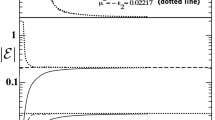Abstract
A large two-body scattering length leads to universal behavior in few-body systems. In particular, the three-body system displays interesting features such as exact discrete scale invariance in the bound state spectrum in the limit of infinite scattering length. Here, I will discuss how an effective field theory (EFT) can be used to study these features and how the finite range of the underlying interaction impacts the bound state spectrum at first order in the EFT expansion.
Similar content being viewed by others
References
Efimov V. (1971). Weakly-bound states of three resonantly interacting particles. Sov. J. Nucl. Phys. 12: 589
Efimov V. (1979). Low-energy properties of three resonantly interacting particles. Sov. J. Nucl. Phys. 29: 546
Braaten, E., Hammer, H.-W.: Universality in few-body systems with large scattering length. Phys. Rep. 428, 259 (2006) and references therein
Platter L. and Hammer H.-W. (2006). Universality in the triton charge form-factor. Nucl. Phys. A 766: 132
Hammer H.-W. and Platter L. (2007). Universal properties of the four-body system with large scattering length. Eur. Phys. J. A 32: 113
Hammer H.-W. and Mehen T. (2001). Range corrections to doublet S wave neutron deuteron scattering. Phys. Lett. B 516: 353
Bedaque P.F., Rupak G., GrieΒhammer H.W. and Hammer H.-W. (2003). Low-energy expansion in the three-body system to all orders and the triton channel. Nucl. Phys. A 714: 589
Platter L. and Phillips D.R. (2006). The three-Boson system at next-to-next-to-leading order. Few Body Syst. 40: 35
Platter, L., Ji, C., Phillips, D.R.: Range corrections to three-body observables near a Feshbach resonance. arXiv:0808.1230 [cond-mat.other]
Efimov V. (1991). Force-range correction in the three-body problem: application to three-nucleon systems. Phys. Rev. C 44: 2303
Efimov V. (1993). Effective interaction of three resonantly interacting particles and the force range. Phys. Rev. C 47: 1876
Thøgersen M., Fedorov D.V. and Jensen A.S. (2008). Universal properties of Efimov physics beyond the scattering length approximation. Phys. Rev. A 78: 020501
Canham D.L. and Hammer H.-W. (2008). Universal properties and structure of halo nuclei. Eur. Phys. J. A 37: 367
Higa R., Hammer H.-W. and van Kolck U. (2008). Alpha-alpha scattering in halo effective field theory. Nucl. Phys. A 809: 171
Author information
Authors and Affiliations
Corresponding author
Rights and permissions
About this article
Cite this article
Platter, L. Universality and Leading Corrections in Few-Body Systems. Few-Body Syst 45, 211–214 (2009). https://doi.org/10.1007/s00601-009-0032-9
Received:
Accepted:
Published:
Issue Date:
DOI: https://doi.org/10.1007/s00601-009-0032-9



